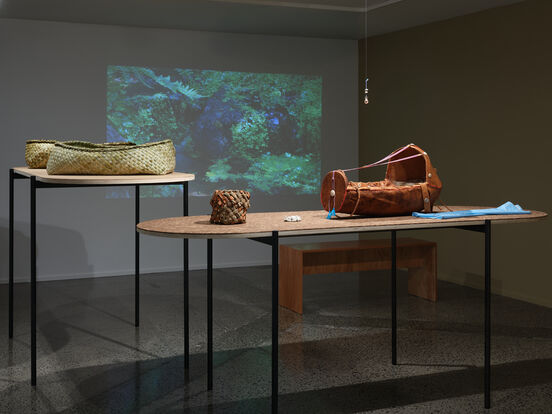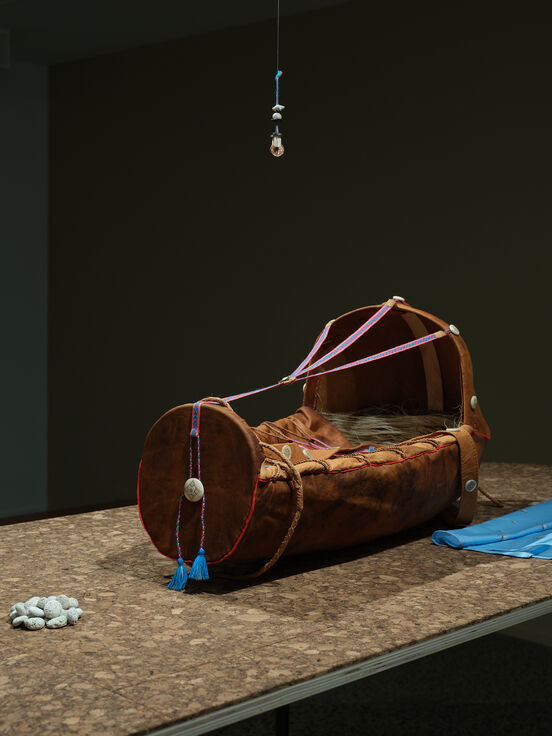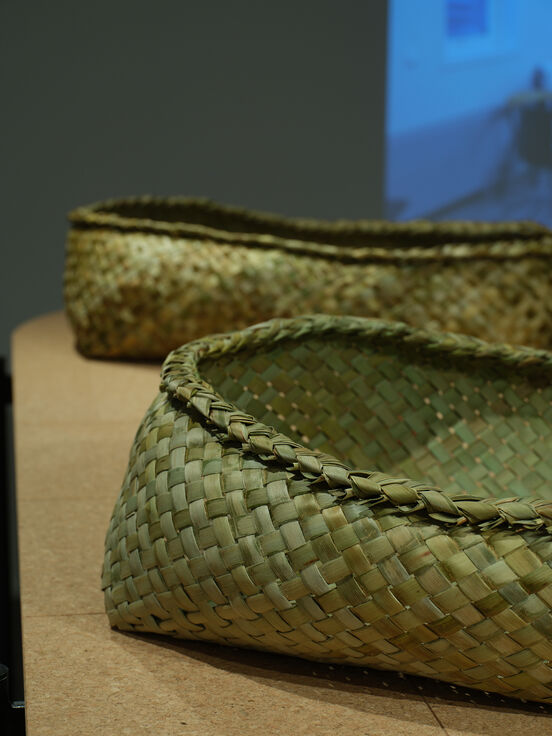Architecture of Aroha presents two objects that hold important cultural significance, the wahakura and the gietkka, baby sleeping vessels from Māori and Sámi communities respectively.
The wahakura and gietkka do not exist purely as objects. Rather, they are part of an intricate constellation of knowledge, design and spirituality.
Their design reflects a deep understanding of the natural world. For each, materials are sourced locally thus echoing the rhythms of the environment and showing the connection between all aspects of life and land for Indigenous peoples.
Within both Sámi and Māori worldviews, the making of the sleeping vessel and its materiality is more than a craft, it’s an expression of ancestral wisdom about care and love and the interconnected world that brings nature, the land, makers, family, ancestors and the extended community together. Brought into dialogue for Architecture of Aroha, these vessels demonstrate how Indigenous peoples consistently conceptualise, innovate, and finely-tune designs to ensure the protection and prosperity of families.
Architecture of Aroha was first presented at the Luleå Biennial 2024. For this iteration, Gunvor Guttorm has worked with Ngaroma Riley to carve the gietkka in Aotearoa.
—
Gunvor Guttorm is Professor in Duodji (Sámi arts and crafts, traditional art, applied art) at Sámi allaskuvla/Sámi University of Applied Sciences, Guovdageaidnu. She has taught both undergraduate and graduate courses in duodji at Sámi University, both practically and theoretically. Gunvor has also written several articles about how the traditional knowledge of Sámi art and craft has been transformed in the modern lifestyle.
Berit Kristine Andersen Guvsám grew up in Steinkjer but also has connections to Divtasvuodna in the Lule Sámi area. She is a duodjár and has a master’s degree in duodje from Sámi allaskuvla/Sámi University of Applied Sciences. Within the duodje field, she works with soft materials such as textiles and leather. Traditional duodje from the Lule Sámi area is the base of her practice.
Tanya Reihana White is a kairaranga (weaver) based in Tāmaki Makaurau Auckland and is a descendant of the tribes of Ngāti Whātua, Ngāti Hineāmaru and Ngāti Maniapoto. As a practitioner for many years, her focus has been on the integration of health and wellbeing between people and the land. Her master’s degree focused on mokopuna wellbeing through the healing practices and tikanga (ways of being and doing) of raranga wahakura (weaving safe sleeping vessels for newborn infants). Tanya currently has a role as kaitiaki taiao at Te Whare Wānanga o Wairaka.
Jasmine Te Hira (Te Rarawa, Ngāpuhi, Atiu, England) is an artist, arts educator and community partnership coordinator from Aotearoa New Zealand. Jasmine has forged a practice that articulates concepts relating to time, memory and perception through the boundaries of object, video and constructed space.
Inga Ravna Eira is an author, teacher and translator. She was born to a reindeer-herding family in Karasjok, Norway, where she still lives. She writes poetry, short stories and children’s books in North Sámi. Together with other artists, she has worked on performance shows, performing her own poems in the musical poetry show Čuollogeađgi / The Silhouette Stone.
—
With thanks to Emily Parr, Karl-Oskar Gustafsson, Manaia Kolio, Mikael Pirak, Ngaroma Riley, Nikau Reihana-Wallis, Ove Stødle and Kaunuku.
Architecture of Aroha is supported by Nordisk Kulturfond’s Globus initiative, Norwegian Crafts, Sámi allaskuvla / Sámi University of Applied Sciences and The Purple Gift.









